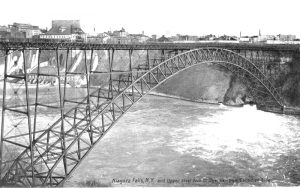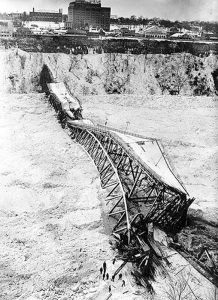Leffert Lefferts Buck (STRUCTURE, December 2010) had long experiences with bridges across the Niagara River. First, he replaced wires and added anchorages to Roebling’s 1855 suspension bridge. He followed this with replacing the wooden trussing with iron and, still later, he replaced the stone towers with iron, all of these without stopping traffic for any extended period. These modifications took place between 1877 and 1886. With his associate R. S. Buck, he replaced Edward W. Serrell’s Lewiston/Queenston Suspension Bridge in 1889. He widened and strengthened Samuel Keefer’s 1868 Honeymoon Suspension Bridge in 1888. Unfortunately, the deck collapsed in a fierce windstorm in 1889, shortly after it opened. He rebuilt it within two months. In 1895, the owners wanted to widen the bridge and have it support trolley traffic. Buck was chosen to design and build an arch bridge under and around his bridge in 1897. He chose a braced arch, open-spandrel span of 840 feet that made it the longest arch span in the world when it opened on June 20, 1898.

In addition to fire, decay, and floods, ice jams had taken out many of the early wooden bridges built in the Northeastern United States. History had shown that ice jams were frequent in this part of the Niagara River below the falls. Buck placed the abutments on the canyon walls at an elevation he believed to be above any recorded ice jams. Six months after the bridge opened, large quantities of ice came over the falls and formed a large ice pack. Usually, this ice was confined to the center third of the river due to strong eddies moving upstream on the sides. This ice pack reached thicknesses of over 100 feet, with up to 80 feet being below the surface and 25 feet above the surface. Buck wrote, the “high water level and the movement of the ice were investigated before fixing the span of the arch and the elevation of the abutments; according to the worst conditions previously known.”
He described the events of January 22, 1899, as follows, “an ice-jam took place which exceeded all past experience. The ice field, firmly anchored to both shores, then caught a heavy run of ice coming down the river, the water of which was greatly augmented by a stiff and long-continued southwest gale on the lakes. At about 4 PM, the river channel under the ice became choked, and within a few minutes, the water near the head of the ice-field rose to a height of 25 feet or 30 feet above its level at the bridge, three-quarters of a mile below, and began to pour over the pack for some distance below the Falls. The pressure caused the whole pack to move downstream. Not only was the ice piled up over the masonry abutments, but it was swept against the steel-work of the arch as high as the upper chord (panel-point 2) on each side of the river. As it struck the rib chords, it was shaved off as with a knife and deposited in large masses upon the upstream truss members and the lower laterals. The bridge quivered from end to end as the ice ground against it but did not sway. The pack moved 250 feet in about 10 minutes, after which the channel underneath the ice cleared and the water subsided as rapidly as it had risen. On each side of the river, one main lateral and one sub-lateral, four members in all, were badly bent. The abutments were uninjured, and no other damage was done.” One account has it that men were put to work with dynamite to keep the ice away from the steelwork as much as possible.

However, the fates were on his side this time, and he straightened the bent struts immediately and replaced them in the spring. He wrote, “in order to guard against similar trouble in the future, heavy concrete walls were built around the abutments, extending as far out in front as possible, and the first two panels of laterals in the plane of the lower chord on each side of the river were changed from latticed struts to plate-webbed struts.”
The bridge was not threatened again until January 25, 1938, forty years later, when a 5-day January thaw and major windstorm off Lake Erie again jammed the river gorge below the falls with ice. The ice rose to over 50 feet above the river’s mean water level and started to move at glacial speed down the river. Despite Buck’s 1899 reinforcement, the ice crumpled the main arch members of the bridge near the skewbacks resulting in the bridge being closed at 9:15 on the 28th. The bridge, surprisingly, held together for another day, and, at 4:20 PM on the 29th, the bridge collapsed into the Niagara River. A reporter for the Evening Review wrote of the failure in the following way,
“Belch may seem a strange term to attach to the death of the long, slim span, yet that was the sound that thundered up to my ears. It was as though the great spidery giant was ridding itself of the terrible pain which had crept up into its bowels, bowels that were struts, spars, rivets, and all those structural bits that went into its creation. The sound was too robust for a sigh, more startling than a cry. And death flicked his grim harp in the echo which fled frantically up and down the cliffs, finally smothered in the spume of flying snow that jerked into the air as the shaking sections crashed into the ice.

Those two sections at the ends slowly sloped downward in a shower of powdery snow, dirt, and tumbling rock. Then the two sections inside these began to rise as though in a frantic effort to escape that mangling death below, attempting to soar skyward. It was a last futile gesture. Slowly – it seemed minutes though it was but split seconds – the giant folded into the masses of ice. The result was a giant “W” for Winter resting on the river ice.”
Fortunately, the early warning kept people off the bridge, and there were no fatalities. Since there was no loss of life, there was no Coroner’s Inquest to look into the failure. With that, over forty years after its opening and thirty years after Buck died, the longest arch span in the world at the time of its construction disappeared. The bridge had served its function well but had fallen prey to the severe weather typical around the Great Lakes.
The owners of the bridge immediately blasted it into three parts as it lay on the ice. After attempts to salvage the steel, they found that they could not remove any portion of it. So it sat there until, on April 12 at 7:10 AM, the ice let loose and the end span dropped into the water to be followed by the sinking of half of the arch on the American side. On the following day, at 3:25 PM, the remaining section of the bridge began to move down the river on the ice. As it moved, the “huge ice floe turned pointing the bridge section like the prow of a freighter as it sailed down the river with the current.” It was described as follows:
“It was a most unusual funeral procession. The spectators followed the progress of the bridge, running along the River Road to keep up with the floating wreck. It continued down river on its icy bier for what seemed an impossible distance for such a heavy weight until it reached a point just opposite the foot of Otter Street, almost a mile from the starting point. Here it sank at 4:05 PM.
Pieces of the wooden deck were shot into the air from the center of the wreck as the end came. Loud cracking noises were heard as the bridge twisted and turned with the ice breaking up beneath it. Soon there was nothing left but floating fragments of the flooring, which were carried down the river. It was a spectacular funeral, in keeping with the dramatic way in which the bridge came to its end.”
The bridge was replaced in 1941 with another steel arch bridge designed by Waddell and Hardesty. It is located about 400 feet downstream from Buck’s Bridge and is a hingeless steel box arch with a span of 950 feet. It, like its predecessor, is called the Honeymoon or Rainbow Bridge.
It may be suggested that Buck should have known the ice could rise this high in the area of his arch abutments. He, however, relied upon historical information to place them above any danger of the ice taking out the bridge. In short, he, like the engineers of today, designed for what he considered a worst-case scenario. Unfortunately, however, a unique set of weather events created an even worst-case scenario, and the bridge failed after a life of 40 years.■
